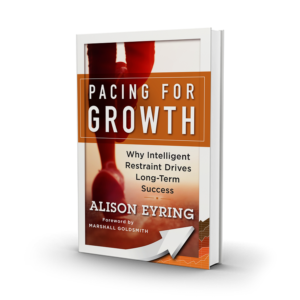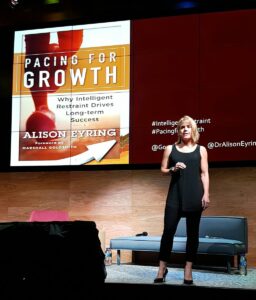Pacing for Growth
Chances are that you’re driven. You have goals, and you’re actively working on them. When you get to work, you’re off and running.
I know this because most people reading this blog are here for success tips to become better leaders and more successful. If you were lazy and drifting without goals, you probably wouldn’t be visiting.
As you push through obstacles, you likely don’t think much about the word “restraint.” In fact, if you do, you may think that the only thing that matters is removing all restraints so you can get to your destination. Fast.
That’s why I was drawn to the work of Dr. Alison Eyring. Her book, Pacing for Growth: Why Intelligent Restraint Drives Long-Term Success, is about the balance between speed and restraint. I asked her to share some of these principles with us so we could learn from her research into what she calls “intelligent restraint.” Alison Eyring is the founder and CEO of Organisation Solutions, and she has advised some of the world’s most innovative companies on leadership and growth.
Solve Your Growth Challenge
How has competing in long-distance runs and triathlons impacted your approach to business?
Like all business leaders, I struggle to drive my business to perform today, as I also lead transformation for the future – all without damaging the business or my team. It’s so much easier to focus on just one of those things, but we have to do all three for long-term success. My experience training for endurance races led me to discover a growth philosophy I call “Intelligent Restraint” that helps solve this growth challenge.
Can you tell us more about “Intelligent Restraint”?
Intelligent Restraint is a growth mindset that helps you build the right capabilities for growth at the right pace. Sometimes it means going slower, and other times it means going faster.
When you are training for an endurance race, you have to push yourself to go as far and as fast as you can but then no further so that you don’t get hurt or burned out. In my book, I describe practical ways leaders can apply this growth mindset. For example, you can define and measure “maximum capacity” of the business and then create a plan to bridge the gap between current levels of performance and “maximum capacity.”
Another way leaders can put this way of thinking to work is by practicing what I call “Rules of Intelligent Restraint.” Like rules of restraint in endurance training, these rules help leaders drive growth in a way that conserves energy and can be sustained. My favorite rule is “routines beat strengths.”
Alison's 8 Insights from Endurance Training
- Always train for the right race.
- Don’t let any mountain defeat you.
- Be good enough when good is enough.
- Find many ways to maintain your own energy.
- Don’t spend your life doing only what you do well.
- Never let others define what success means for you.
- Be courageous and be humble; persevere and be willing to stop.
- Never be intimidated by anyone who looks stronger and faster than you.
Train for the Right Race
How do leaders find the right balance between the sprint and the marathon?
You can’t sprint and run long distance unless you’ve trained properly. A midfielder in soccer, for example, will sprint the entire game AND also run several miles. They’ve trained for this. On the other hand, if you ask a world class sprinter to run a marathon tomorrow, they might possibly complete a half marathon but they’ll be in tremendous pain.
As leaders, we need to train our business and our people for the right race. We all want to succeed over the long-term as a business, but there is seldom a long-term unless we can deliver in the short-term and have enough energy to keep going. Leaders who can practice the rules of Intelligent Restraint and manage energy strategically can achieve this.
Focus Overrules Vision
I’d love for you to share your perspective on “focus.”
The first rule of Intelligent Restraint is “Focus overrules Vision.” Clearly vision is important. But any endurance athlete will tell you that while vision gets you to the race, it’s focus that gets you across the finish line.
In my company’s research and our experience working with growth leaders around the world, we find that growth leaders relentlessly create the right focus across the organization. This focus allows employees at all levels of the business to prioritize and to say no to less important activities. Focus empowers people to align themselves with what matters. It conserves energy and resources for the long-haul.
Energy plays into so much of your work. What’s the best way for a leader to manage energy personally and for the team?
We can start by thinking of “energy” as a strategic asset for a business. You can feel it in a business when there is momentum and a great culture. You can feel it in a team that is really humming or when you’re working on something that excites you.
There are lots of ways leaders can manage energy in their business. For example, we can proactively find opportunities to conserve energy and liberate resources by creating the right focus and routines. With our teams, we can talk about what gives them energy and what zaps it so they can do more to build it and less to burn it out. I also believe we need to be role models for exerting on what really matters and then recovering to recharge our batteries and renew our passion for what we do.
 What are the signs of a culture failing to practice Intelligent Restraint as compared to one that is fully using it to go the distance?
What are the signs of a culture failing to practice Intelligent Restraint as compared to one that is fully using it to go the distance?
Samsung’s release of the Galaxy 7 was a recent example of a business that simply went too fast. In their haste to beat Apple, they didn’t really understand the battery requirements and literally flamed out. I suspect we’ll look back on Uber as an example of a company that failed to scale the leadership capabilities they needed to sustain business growth.
It’s harder to spot it when companies go too slow, but a sure sign is when a company announces a “transformation” effort and then fires or lays off a big chunk of its workforce claiming they need different skills in the future. This is common when a business fails to push its people to develop fast enough to remain relevant. When this happens, it’s a tragedy.
If you’re curious about whether your business is pacing for growth, take this super short and simple free quiz: https://organisationsolutions.typeform.com/to/PkjxE6. If your business is great at this, chances are that you and others are already leading this way! But if not, then you can start to identify simple actions you can take to make a difference.
What’s the best way to start leading with “Intelligent Restraint”?
In my own experience as an endurance athlete and as a leader, I’ve found that pacing myself, my team and my business for long-term success always requires me to push harder to create routines for growth that put me and others outside our comfort zone. This is so hard to do.
For more information: Pacing for Growth: Why Intelligent Restraint Drives Long-Term Success.

